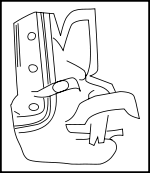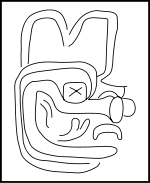
Las Limas Monument 1
Encyclopedia
.jpg)
Greenstone (archaeology)
Greenstone is a common generic term for valuable, green-hued minerals and metamorphosed igneous rocks and stones, that were used in the fashioning of hardstone carvings such as jewelry, statuettes, ritual tools, and various other artefacts in early cultures...
figure of a youth holding a limp were-jaguar
Olmec were-jaguar
The were-jaguar was both an Olmec motif and a supernatural entity, perhaps a deity.The were-jaguar motif is characterized by almond-shaped eyes, a downturned open mouth, and a cleft head. It appears widely in the Olmec archaeological record, and in many cases, under the principle of pars pro toto,...
baby. Found in the Mexican state of Veracruz
Veracruz
Veracruz, formally Veracruz de Ignacio de la Llave officially Estado Libre y Soberano de Veracruz de Ignacio de la Llave , is one of the 31 states that, along with the Federal District, comprise the 32 federative entities of Mexico. It is divided in 212 municipalities and its capital city is...
in the Olmec heartland
Olmec heartland
The Olmec heartland is the southern portion of Mexico's Gulf Coast region between the Tuxtla mountains and the Olmec archaeological site of La Venta, extending roughly 80 km inland from the Gulf of Mexico coastline at its deepest...
, the statue is famous for its incised
Incised
Incised means cut, particularly with a "V" shape. It is a term found in a number of disciplines.-Geology: In geomorphology, the term Incised refers to when a river has cut downward through its riverbed. The river may have been incising through sediment or bedrock. The river begins at one elevation...
representations of Olmec supernaturals and is considered by some a "Rosetta stone
Rosetta Stone
The Rosetta Stone is an ancient Egyptian granodiorite stele inscribed with a decree issued at Memphis in 196 BC on behalf of King Ptolemy V. The decree appears in three scripts: the upper text is Ancient Egyptian hieroglyphs, the middle portion Demotic script, and the lowest Ancient Greek...
" of Olmec religion. The largest known greenstone
Greenstone (archaeology)
Greenstone is a common generic term for valuable, green-hued minerals and metamorphosed igneous rocks and stones, that were used in the fashioning of hardstone carvings such as jewelry, statuettes, ritual tools, and various other artefacts in early cultures...
sculpture, it is also known as the Las Limas figure and the Señor de las Limas.
Interpretation
Sculptures of headdressed figures holding inert were-jaguar babies appear often in the Olmec archaeological record, from the smallest of figurines to the huge table-top thrones such as La VentaLa Venta
La Venta is a pre-Columbian archaeological site of the Olmec civilization located in the present-day Mexican state of Tabasco. Some of the artifacts have been moved to the museum "Parque - Museo de La Venta", which is in Villahermosa, the capital of Tabasco....
Altar 5.
What these sculptures symbolised to the Olmecs is not clear. Some researchers, focusing on the symbolic cave surrounding the figure on Altar 5 believe that these sculptures relate to myths of spiritual journeys or human origins. Others find that the limp depiction of the were-jaguar baby denotes child sacrifice.




Incisions
The faces of four supernaturals are incised onto the shoulders and shins of Monument 1. Further tattoo-like incisions, but more abstract, cover the youth's face around the mouth and in bands alongside the face.The four supernaturals show several common Olmec motifs, in particular the cleft head.
Las Limas Hypothesis
Monument 1's iconography has led noted Olmec scholar Michael D. CoeMichael D. Coe
Michael D. Coe is an American archaeologist, anthropologist, epigrapher and author. Primarily known for his research in the field of pre-Columbian Mesoamerican studies , Coe has also made extensive investigations across a variety...
to develop the "Las Limas Hypothesis". Coe believes that the four supernaturals, along with the were-jaguar baby, are representatives of the Olmec pantheon
Pantheon (gods)
A pantheon is a set of all the gods of a particular polytheistic religion or mythology.Max Weber's 1922 opus, Economy and Society discusses the link between a...
. Coe's student, Peter Joralemon, added three more deities to the five in his widely-cited 1971 paper on Olmec iconography.
History
The statue is 55 cm (22 in) high, 42 cm (16 in) wide, and weighs an estimated 60 kg (132 lb). It was probably carved during the Middle Formative Period, some time between 1000 to 600 BCECommon Era
Common Era ,abbreviated as CE, is an alternative designation for the calendar era originally introduced by Dionysius Exiguus in the 6th century, traditionally identified with Anno Domini .Dates before the year 1 CE are indicated by the usage of BCE, short for Before the Common Era Common Era...
).
The statue was discovered in near Jesús Carranza, Veracruz
Jesús Carranza, Veracruz
Jesus Carranza is a town and municipality located in the State of Veracruz, in Mexico. The town has an area of 486.32 kilometers squared. It represents about 0.67 percent of the State of Veracruz. Jesus Carranza borders the State of Oaxaca to its west. It is located 435 kilometers from the...
, by two local children, Rosa and Severiano Paschal Manuel. Dug out and taken to their nearby home, it was declared the "La Virgen de las Limas" and set up on its own altar. Word of the find reached archaeologists in Xalapa
Xalapa
Xalapa-Enríquez, commonly Xalapa or Jalapa, is the capital city of the Mexican state of Veracruz and the name of the surrounding municipality. In the year 2005 census the city reported a population of 387,879 and the municipality of which it serves as municipal seat reported a population of...
. After promising to keep the statue on display — and to build a local school — the archaeologists moved the sculpture to the Xalapa Museum of Anthropology.
Five years later, in October 1970, the statue was stolen from the museum, only later to be found in a motel room in San Antonio, Texas
San Antonio, Texas
San Antonio is the seventh-largest city in the United States of America and the second-largest city within the state of Texas, with a population of 1.33 million. Located in the American Southwest and the south–central part of Texas, the city serves as the seat of Bexar County. In 2011,...
, apparently too famous to be sold on the black market.
It is presently on display at the Museo de Antropología de Xalapa, in Veracruz.


